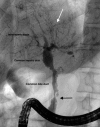Large-duct cholangiopathies: aetiology, diagnosis and treatment
- PMID: 31288256
- PMCID: PMC6583582
- DOI: 10.1136/flgastro-2018-101098
Large-duct cholangiopathies: aetiology, diagnosis and treatment
Abstract
Cholangiopathies describe a group of conditions affecting the intrahepatic and extrahepatic biliary tree. Impairment to bile flow and chronic cholestasis cause biliary inflammation, which leads to more permanent damage such as destruction of the small bile ducts (ductopaenia) and biliary cirrhosis. Most cholangiopathies are progressive and cause end-stage liver disease unless the physical obstruction to biliary flow can be reversed. This review considers large-duct cholangiopathies, such as primary sclerosing cholangitis, ischaemic cholangiopathy, portal biliopathy, recurrent pyogenic cholangitis and Caroli disease.
Keywords: biliary cirrhosis; biliary strictures; endoscopic retrograde pancreatography; portal hypertension; primary sclerosing cholangitis.
Conflict of interest statement
Competing interests: None declared.
Figures




References
Publication types
LinkOut - more resources
Full Text Sources
